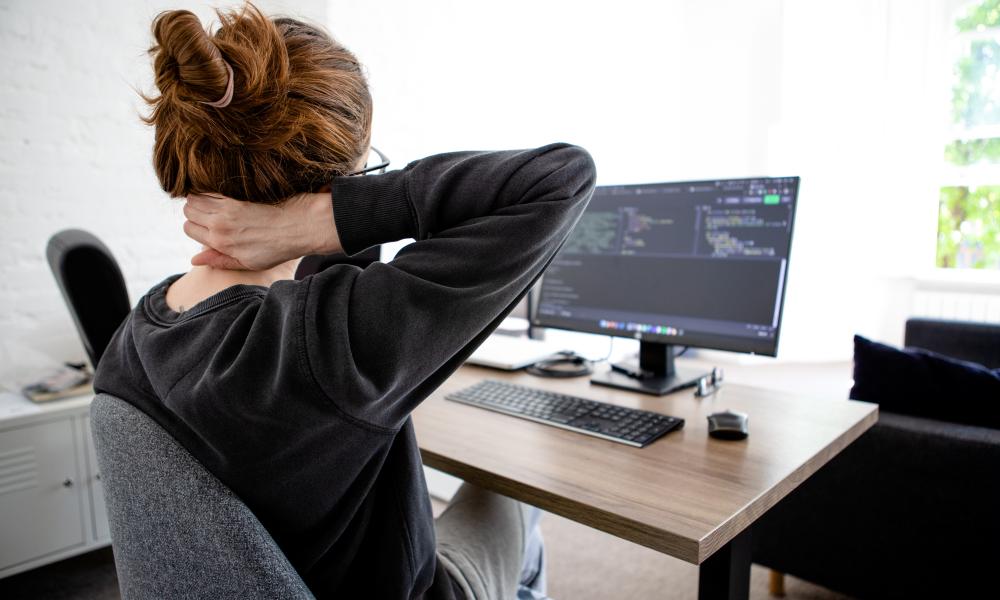
DITCH THE CHAIR AND GET ACTIVE: FIVE WAYS TO AVOID NECK AND BACK PAIN
According to the World Health Organization, lower back pain affected 619 million people globally in 2020 and was the leading cause of disability. In most cases there is no specific explanation for the pain.
However, there are a number of things we can do to reduce the risk of such pain.
1 Get active
Studies suggest that exercise may improve the delivery of essential nutrients to the discs that sit between the vertebrae, while exercise also strengthens muscles.
“Taking some regular aerobic exercise is probably the best prevention [for back and neck pain],” said Michael Grevitt, a consultant spinal surgeon in Nottingham. That could include a variety of activities that get the heart pumping, such as walking, jogging, cycling and swimming.
However, it is also important to stretch the hamstrings and gluteal muscles and build core stability. Among other exercises for the latter, recommended by the NHS, are knee hugs, knee rolls and pelvic tilts.
Dr Stephen Humble, a consultant in spinal medicine in London, said 30 minutes of exercise a day was a good goal, but that it was important to ease into such a regime. “I’ve seen so many people with prolapsed discs because they’ve been overdoing it in the gym,” he said.
Prof Peter O’Sullivan, a specialist musculoskeletal physiotherapist at the Curtin School of Allied Health, Australia, added that relaxing, sleep, a healthy diet and good mental health were also important preventive measures.
2 Quit smoking
A number of studies have linked smoking with back and neck pain. It is possible that some people smoke because they are in pain, or that the link is down to associated factors such as being sedentary. However, experts have suggested smoking could itself contribute towards back and neck pain.
“Smoking has been shown to decrease the blood flow to the intervertebral discs and increases the rate of degeneration,” said Grevitt. “Hence, back pain is more prevalent in smokers and combined with a general lack of fitness has a greater impact and related disability.”
Philip Sell, a retired consultant spinal surgeon in Leicester, said that obesity was also a risk factor for back pain, but again the situation was complex. “If you’re morbidly obese, you’re usually very sedentary,” he said.
3 Ditch the chair
“We’ve evolved from hunter-gatherers. So sitting behind a computer, or sitting around staring at phones all day, is not really what we’re designed to do,” said Grevitt.
However, pressures are placed on the spine in the optimal way when standing, said Sell.
If you have a desk job, you may want to consider swapping your chair for a height-adjustable standing desk. Grevitt said: “There’s a lot of evidence that alone can reduce your workers’ burden of back pain.”
Where that is not practical, there are other options. “There are good chairs around which provide lumbar and also thigh support,” he said.
Why sitting is so bad for the back is not entirely clear, with the role of posture in back and neck pain the subject of controversy.
Humble is among those who believes posture matters. “If you slump forward and your chin goes forward, then it puts a lot more weight on the joints within the neck and therefore it accelerates the wear and tear. It also puts strain on the muscles, ligaments,” he said.
But O’Sullivan offered a different view. “Sitting is not so much about posture, it’s about being sedentary. We are made to move,” he said. “Find postures that are relaxed and comfortable – vary them and get up and move regularly.”
4 Take care when lifting
According to the union Unison, 300,000 people in the UK experience back pain each year as a result of manual-handling accidents.
To lift safely, squat, hold the load close to your body with both hands, keep your back straight and straighten your hips and knees to stand.
5 If pain strikes, do not stay in bed
“The longer you stay in bed, the worse your disability will be,” said Grevitt.
Related: ‘You’re on your own’: the misery of being out of work with back pain
Part of the issue, he said, was that people with back pain tend to avoid activity as they worry it could make the pain worse.
“By doing that, muscles that should be worked to maintain good posture and a balanced spine become rapidly reconditioned,” said Grevitt. “Paradoxically, early resumption of activity reduces the overall period of disability.”
O’Sullivan also cautions against being overprotective. “For most people, back and neck pain is not a sign of tissue damage,” he said.
However, Sell said pain that does not improve over time, or that it is associated with changes to bowel or bladder habits, was among the signs that you should seek medical help.
2024-01-19T20:07:50Z dg43tfdfdgfd